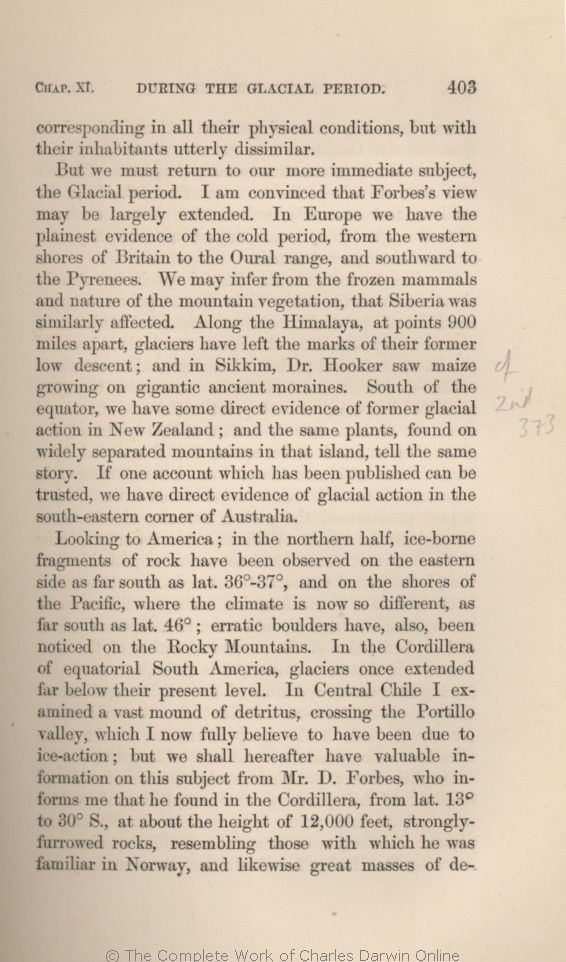But we must return to our more immediate
subject, | subject, 1859 1860 1861 | | subject. 1866 1869 1872 |
| the 1859 1860 1861 | the 1866 1869 1872 |
| Glacial 1859 1860 1861 | Glacial 1866 1869 1872 |
| period. 1859 1860 1861 | period. 1866 1869 1872 |
| Forbes's 1859 1860 1861 1866 1872 | | Forbess 1869 |
| have 1859 1860 1861 | | meet with 1866 1869 1872 |
| cold 1859 1860 1861 | | Glacial 1866 1869 1872 |
| infer 1860 1861 1866 1869 1872 | | infer, 1859 |
| 1 blocks not present in 1859 1860 1861; present in 1866 1869 1872 | | In the Lebanon, according to Dr. Hooker, perpetual snow formerly covered the central axis, and feed
glaciers which rolled 4000 feet down its
valleys.
|
| gigantic ancient 1859 1860 1861 1866 1869 |
| ancient and gigantic 1872 |
|
Looking to
America; | America; 1859 1860 1861 1866 1869 | | America: 1872 |
| as 1859 1860 1861 1866 |
| of the continent, as 1869 1872 |
| 36°-37°, 1859 1860 1861 1872 | | 36°-37°, 1866 | | 36°— 37°, 1869 |
| 46°; 1859 1860 1861 | | 46°; 1866 | | 46°. 1869 | | 46°. 1872 |
| erratic 1859 1860 1861 1866 | | Erratic 1869 1872 |
| equatorial 1861 1866 | | Equatorial 1859 1860 | equatorial 1869 1872 |
| glaciers 1859 1860 1861 1866 |
| nearly under the equator, glaciers 1869 1872 |
| present 1859 1860 1861 1869 1872 | | presen 1866 |
| Central 1861 1866 1869 1872 | | central 1859 1860 |
| Chile 1859 1861 1866 1869 1872 | | Chili 1860 |
| examined 1861 1866 1869 1872 |
| was astonished at the structure of 1859 1860 |
| detritus, 1859 1860 1861 | | detritus 1866 1869 1872 |
| about 800 feet in height, crossing a valley of the Andes; and this I now feel convinced was a gigantic moraine, left far below any existing glacier. 1859 1860 |
| with great boulders, crossing the Portillo valley, which there can hardly be a doubt once formed a huge moraine; and Mr. D. Forbes informs me that he found in various parts of the Cordillera, from lat. 13° to 30° S., at about the height of 12,000 feet, deeply-furrowed rocks, resembling those with which he was familiar in Norway, and likewise great masses of detritus, including grooved pebbles. 1869 |
| with great boulders, crossing the Portillo valley, which there can hardly be a doubt once formed a huge moraine; and Mr. D. Forbes informs me that he found in various parts of the Cordillera, from lat. 13° to 30° S., at about the height of 12,000 feet, deeply-furrowed rocks, resembling those with which he was familiar in Norway, and likewise great masses of detritus, including grooved pebbles. 1872 |
|









